In our first lesson in ecology we mentioned that the type of sediment plays a big role in determining which plants will live in a particular community. If you visit a local salt marsh you find a lot of muck and mire. But that is not how it began, that is the result of the plants being there. At the beginning of the pioneer community process you had quartz sand just as you do anywhere else on a barrier island in the northern Gulf of Mexico. And this is just how we start a marsh when planting a living shoreline project – quartz.

Photo: Rick O’Connor
Another factor for establishing a salt marsh community is the need for the plants to be in a low energy environment – energy meaning waves. Some marshes do grow in large open areas of a bay, but they do not grow into large expansive marshes – and marshes do not grow on the Gulf side of the islands. On the estuary side you will find them in areas where the fetch (distance across the water which the wind blows) is relatively small. Most marshes will grow in well protected coves.

Here the grasses of the marsh germinate and survive. And it is grasses. A wetland area dominated by grasses is called a marsh, one dominated by trees is called a swamp. Most of the wetland trees in north Florida cannot tolerate salt water. However, there are some in south Florida – mangroves – and there, mangrove swamps occur in places where north Florida salt marshes would.
These grasses are what we call emergent grasses – meaning they are rooted in the substrate and submerged, but the leaves extend above the surface of the water and into the sunlight. The variety of grasses that grow in salt water like this is low, but their abundance is high. High density (number of shoots/area2) is high. These dense fields of emergent grasses growing along the shore trap much of the sediment running off the island forming thick layers of sediment within the marsh. As plants die, both on the island and within the marsh, the leaf litter accumulates here and is broken down by decomposing bacteria forming the muck and mire we are familiar with when we walk through a marsh. The decomposition process consumes dissolved oxygen and releases hydrogen sulfide, which smells like rotten eggs and has been given the term “swamp gas”.
In the northern Gulf, marshes are dominated by two species of grass – smooth cordgrass (Spartina alterniflora) and black needle rush (Juncus roremerianus). Smooth cordgrass is a bright green colored plant with several leaves extended up and out. It tolerates being partially submerged more than the needle rush and so is encountered first as you approach the marsh from the open water. It resembles a field of corn. The black needle rush is a tall spine. It is a brown-gray in color and grows almost five feet high. It grows in the upper marsh where it is actually wet only at high tide. Like cordgrass, it can form very dense fields of grass that can be difficult to walk through – and being closer to land with less tidal flushing, is where most of the mud will be found. There are other plants that grow in a marsh, such as marsh hay (Spartina patens) and salt bush (Baccharis sp.) that grow at the upper edge of the upper marsh, but the community is dominated by cordgrass and needle rush. And, as mentioned, there is a definite zonation where the cordgrass ends, and the needle rush begins. Some marshes do not have the zone of cordgrass in the lower marsh. This may be due to a lower salinity. Smooth cordgrass does like a more saline environment, say 20‰, and the upper parts of an estuary you may find only needle rush (who can tolerate lower salinities).
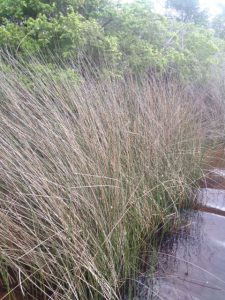
Photo: FDEP
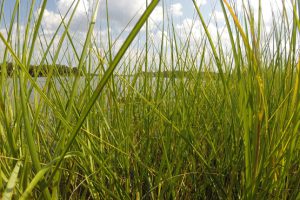
Photo: FDEP
These dense fields of grass provide an abundance of food for herbivores who can tolerate living in a wetland that is very wet during high tide and has a muddy substrate with hydrogen sulfide. But interestingly, most of the grazers here do not eat the grass directly. Most feed on the leave litter that has fallen (so they are saprovores) or on smaller plants growing on the grasses (epiphytes). These grazers must be able to tolerate high tide periods where there will be saline water and low tide where there will be no water at all.
One of the more visually abundant species is a small snail called the marsh periwinkle (Littorina irrorata). This small, semi-spherical, snail spends its time on the sediment during low tide feeding on detritus (decaying plant and animal material – the organic muck of the marsh) and then crawls up the blades of grass during high tide to avoid predators such as blue crabs and diamondback terrapins. They can be very abundant and hundreds of white snails can be seen at the tops of the swaying grasses.
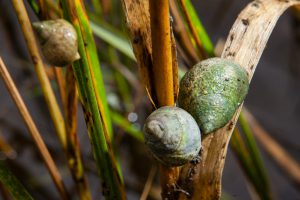
There are numerous species of insects that feed on the detritus as well. Swamps and marshes are famous for their biting insects. Spiders, butterflies, and dragonflies can all be found as well.
In the lower marsh where it is submerged more frequently you can find filtering feeding bivalves, such as oysters and ribbed mussels. These animals are famous for their filtering capacity, helping to remove sediments, nutrients, and improving water clarity. There are numerous filter feeding, or detrivorous fishes here as well. Members of the killifish family (longnose, gulf, and bayou killifish) are one of the more common and can tolerate a wide range of salinity. Mullet, flounder, silversides, mollies, and the juveniles of numerous species such as croaker, pinfish, and speckled trout can also be found here. Actually, it has been found that 80% of the commercially valuable fin and shellfish in our estuarine fisheries spend at least part of their time hiding and feeding in these marshes.

Another visually abundant species is the fiddler crab. There are actually several different species of this creature in the genus Uca but it is not easy to tell them apart when hiking the marsh. They live in small burrows they dig emerging during low tide to roll the sediment into small round balls called “pseudo-feces” and clean the organic material off as a food source while doing so. When they are out, they can form large “herds” of literally hundreds of small crabs moving across the landscape like a herd of cattle. When the tide rolls in, they enter their burrow and seal it off awaiting low tide. They are called fiddlers because the males possess one larger claw which they wave in the air to attract females and warn off revival males. It looks like they are playing the fiddle when they are doing this – hence their common name.
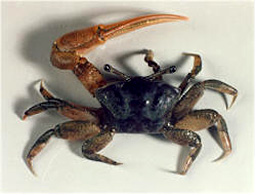
Photo: University of Southern Mississippi
Not as visually abundant as the periwinkles and fiddler crabs, but abundant none the less are the crustaceans. Blue crabs as well as brown and white shrimp are very abundant here. They, like the other grazers, feed on the detritus the marsh provides. They also support a HUGE commercial fishery. All of these grazers are very hardy species. They must be able to tolerate periods of water and no water as well as drastic changes in salinity during the day. They are pretty tough.
With all of these small grazing animals you would expect a lot of larger predators. The trick is getting to the prey. There are often numerous creeks meandering through the marshes that will allow a few larger predatory fish to enter. However, these fish will have to tolerate a lower salinity than in the open bay. Tarpon, gray snapper, redfish, and flounder are a few who do. Occasionally stingrays can be found in the deeper creeks.

Photo: NOAA
With the close proximity of dry ground nearby there are both reptiles and mammals that enter the marsh seeking food. The salt marsh snake and cottonmouth have both been found. As the name indicates, the salt marsh snake specializes in living and hunting here. Cottonmouths are more known for their occurrence in freshwater habitats, but their numbers are high on barrier islands and they are often found basking at the edge of these marshes. It is not believed they drink brackish water so a source of freshwater is needed. On some islands, they have been found drinking after a rain from overturned magnolia leaves. So, they find a way.
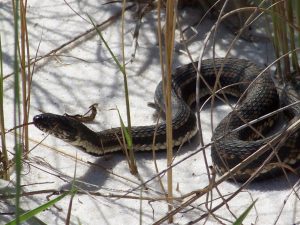
Photo: Molly O’Connor
Diamondback terrapins are the only turtle in the U.S. who lives in brackish water, and salt marshes are their favorite haunts. They feed on a variety of shellfish but may take an occasional killifish if the opportunity presents itself.
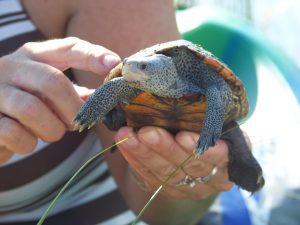
Photo: Molly O’Connor
The primary mammal visitor is the raccoon. These crafty predators wander through the marsh looking for opportunities to grab fish or crabs but are good at opening and eating bivalves as well. River otters have been found in salt marshes chasing crabs and fish and there is a marsh rat that is common – though it is not a predator in this community but rather a seed eater.
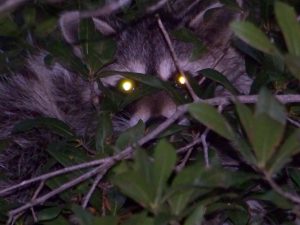
Photo: Molly O’Connor
One predator who has no problem entering the marsh no matter the water height or salinity are the birds. The variety of birds found in a marsh is amazing. The long-legged herons and egrets can walk across the muddy bottoms with their wide spaced toes without sinking or getting wet. Here they hunt for fish, crabs, and shrimp. Clapper rails and seaside sparrows live and nest within the grasses themselves. Red-winged black birds are common seed eaters. And there are numerous species that do not live in, but visit the marsh – such as gulls, terns, pelicans, osprey, and even bald eagles.

Photo: Molly O’Connor
These are not just biological communities of interest to scientists. Salt marshes are important for the health of the entire estuarine system. They are one of the more biologically productive ecosystems on the planet and provide an important nursery ground for open estuarine species as well as some species who spend their adult lives in the open Gulf. They slow barrier island movement and erosion and remove a lot of sand, silt, mud, and leave debris that would otherwise find its way to the open bay decreasing water clarity and making it more difficult for submerged seagrass meadows to exist – which is the topic for marine ecology lesson 3, seagrass meadows.
ACTIVITIES
- Honestly, the best activity here is to make a trip through one of our local salt marshes. This can be done on foot or in a kayak/paddleboard down one of the creeks. Couple of notes before you head out.
- Wear protective clothing. The quick-dry materials used by fishermen work well for protection and staying cool. We recommend long sleeves and pants. This not only protects you from the sun but can help some against briars, etc.
- Wear a hat and sunscreen.
- Bring a small backpack with snacks, water, and cell phone. Depending on your pack you may need a water proof bag for your phone.
- Footwear in a marsh is tricky. You will need something that can (a) get wet and (b) fit snug. The mud/muck of a salt marsh is famous for “stealing shoes”. We do not recommend crocs. They come off easy and I have seen oyster shells cut through them. A pair of closed toed Keens (or similar brand) that can be tightened down seem to work best. Tennis shows will work but (a) they will get wet and muddy and (b) they tend to come untied.
Reference
Whitney, E., D.B. Means, A. Rudloe. 2004. Priceless Florida. Pineapple Press. Sarasota Fl. Pp.423.
 0
0
